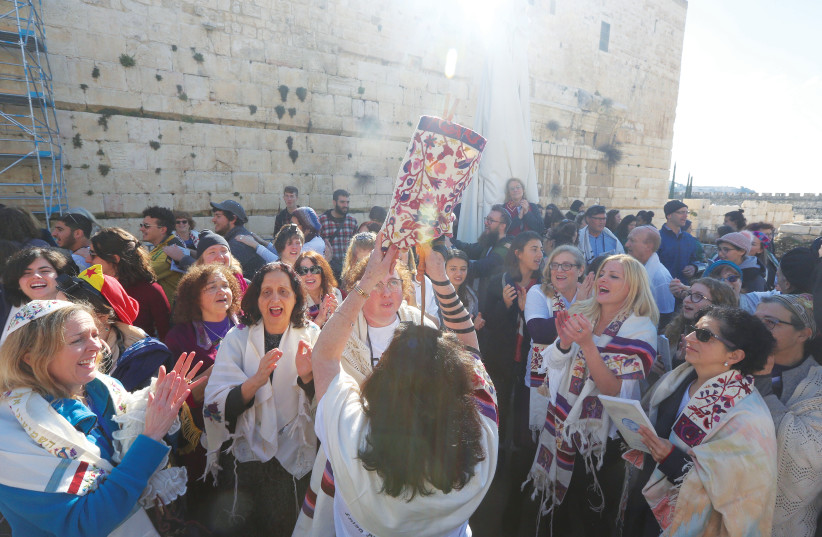Let me start with a disclaimer – what follows isn’t a halachic analysis of Simhat Torah. Rather, I want to share some reflections on the holiday, its origin and meaning, and touch on how women’s celebration of Simhat Torah has evolved over the past generation.
It’s instructive to explore the background of Simhat Torah. In Shir Hashirim Rabbah 1:9 in reference to Simhat Torah, we read: And [Shlomo] went to Jerusalem, stood before the Ark of the Covenant of God and offered burnt offerings and peace offerings... and he made a banquet for all his servants” (Kings I 3:15). Rabbi Elazar said: From here we learn that one makes a feast for the completion of the Torah.
In the Zohar it says: And Yisrael is accustomed to rejoice on this day, and call it Simhat Torah. And they crown the Sefer Torah with its crown, as the Sefer Torah is a hint to Tiferet, the Shechina – the crown of Tiferet.
Rav Joseph Soloveitchik z”l writes that during the whole of Sukkot we go around the Sefer Torah, acknowledging its central importance in Jewish life. But on Shmini Atzeret/Simhat Torah we withdraw the Sifrei Torah to the periphery of the circle and march around God who is at the center. “For seven days we commit ourselves to the centrality of the Torah and Halacha in our lives. And only then, on Shmini Atzeret and Simhat Torah, does the Torah itself incline us towards that awesome Presence in the center of the circle.” While we are rejoicing in the Torah we are drawn close to Hashem, who is our center.
In describing Simhat Torah, Dr. Bryna Jocheved Levy, renowned Tanach scholar and author and distinguished Matan faculty member, writes that on Simhat Torah, upon completion of the yearly cycle of the Torah reading, the congregation experiences a great sense of accomplishment and satisfaction. They recite Chazak Chazak V’nitchazek (“Be strong, be strong and continue to be strengthened”). Then, as if responding to a request for an encore, we begin reading Bereishit/Genesis. This, Levy writes, is a dramatic illustration of the fact that our preoccupation with the Torah hasn’t ended but has only just begun. On Simhat Torah we close and reopen the circle – we are starting a new year, filled with opportunities for spiritual growth and hope for the future.

Simhat Torah celebrates the Torah as our eternal light, strength and source of blessing. The Torah begins and ends with blessings. At the start of Parshat Lech Lecha, in God’s first communication with our patriarch Abraham, He bestows on him multiple blessings. In 12:2-3, the word blessing appears five times in one form or another – “I will make you into a great nation and I will bless you; I will make your name great and you shall be a blessing; I will bless those who bless you; all the families of the earth shall bless themselves by you.”
And the Torah ends with the blessings with which Moshe bids the Israelites farewell. Another way the Torah begins and ends with blessings is that one who is called up for aliyah recites a blessing at the beginning of the reading and again at the end. Once again we see that the Torah is surrounded by blessings.
The Sefat Emet explains that the opening blessing is on the essence of Torah itself whereas the closing one is on the illumination and strength that arises from studying and living Torah to its fullest. By the time we reach Simhat Torah and we finish the reading of the entire Torah cycle, we better understand what a precious gift we’ve been given, what it means to have the privilege of living and studying Torah L’shma – learning for its own sake – and the insight that this brings blessings to us as individuals, to the Jewish nation and to the world.
The Sefat Emet also explains that the dancing and joyfulness of Simhat Torah come from having studied Torah all year long. By rejoicing on the holiday, we grow even closer to God and the Torah, connecting us to Him for the year to come. “Mah ahavti Toratecha, kol hayom hi sichati” - “O how I love Your teaching! It is my study all day long” (Psalms 119:97). Torah is the connector, enabling us to remain in God’s presence every single day.
A generation ago, Simhat Torah was a spectator sport for women –we watched the men sing and dance with the Sefer Torah. That is no longer the case. Today, women have taken huge strides forward. We no longer only watch from behind the mehitza; we also sing and dance with or without a Sefer Torah and there are women’s readings as well. In short we actively convey our simha in Torah, understanding that it is our heritage and privilege, our light and the source of our elation. This kind of active participation is now embedded in our frame of thought and action.
A modern-day blessing for women is that we have options that come from knowledge. We can decide how to express our personal delight and happiness in Torah in a variety of ways. What we also have, thanks to high level institutions like Matan: the Sadie Rennert Women’s Institute for Torah Study, is the opportunity for women to study Tanach, Talmud, Halacha and more in breadth and depth and to be taught and guided by erudite women scholars and teachers, talmidot chachamot. Today we can say with confidence not only Aseh lecha Rav but Asi lach Rabbanit!
The writer founded Matan: the Sadie Rennert Women’s Institute for Torah Study in 1988 and until recently served as chancellor. She is now the president of Matan.
